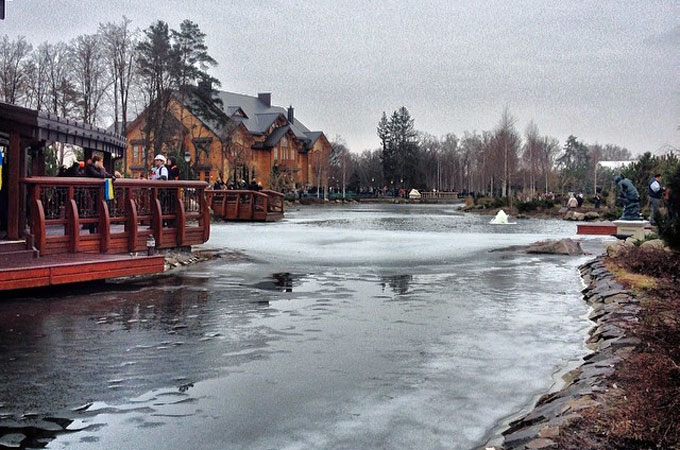Behind the decadence of a Ukrainian president
With ousted President Viktor Yanukovich believed to be in hiding, protesters have flung open the gates to his estate.

Kiev, Ukraine – Bubbling fountains, vintage cars, several ostriches and a golf course – the overwhelming opulence of former Ukrainian President Viktor Yanukovich’s estate, Mezhyhirya, used to be a well-guarded secret. But this once carefully fortified residence is now under the control of EuroMaidan activists, who opened up the territory to the public as a “Museum of Corruption” on Saturday morning.
By mid-afternoon, the normally quiet road to Yanukovich’s estate was congested with traffic as Ukrainians came to see what years of corruption afforded their now ex-president.
“After standing on Maidan for such a long time, I want to see how Yanukovich lived on our money,” said Mikhail Nikolechyk, a resident of the western Ukrainian city of Lviv, as he was walking towards Mezhyhirya.
|
|
| Inside Story: Ukraine’s new reality |
“I’m on the lookout for the tree stumps Yanukovich used for sports training,” the 60-year-old said wryly, referencing a popular YouTube video that shows the former president jumping on tree stumps at his estate.
Up until yesterday, only a small collection of videos and fuzzy snapshots were available of the former president’s estate. A four-metre green, metal fence guarded the 140-hectare territory, which sits 21 kilometres from Kiev in a town named Novi Petrivtsi.
On Saturday, activists were perched around the main entry way, directing people into the compound with loudspeakers, with an obvious zest for the irony of the situation.
Layers of decadence
Beyond the first gate, one crosses an asphalt track that encircles the estate before coming to a black gate with golden detailing. A giant house – part wood, part stone – sits in the centre of the grounds, with rear windows looking out over the Dniper River. A series of ponds and stone pathways weave through the neatly kept green grass, and lawn ornaments – ranging from a giant white horse to a tiny brass squirrel – dot the landscaping at the front entrance.
“This is nicer and more European than any park we have in Ukraine,” Anna Polishko told Al Jazeera, while standing on one of the brick pathways near a side entrance. The 31-year-old said she and two of her friends had driven from Kiev “because we wanted to believe that Viktor Yanukovich was no longer the president”.
“It’s a bitter-sweet feeling, being able to walk around the estate,” she said. The victory against Yanukovich’s government came at a hefty price, she said.
In the past week of protests, more than 70 people were killed and some 500 injured when Yanukovich’s government tried to subdue the three-month protests with force.
|
|
| Analysis: The fall of Yanukovich and the future of Ukraine |
“It’s hard to put together the deaths of a hundred people on Maidan with the estate’s excess,” said Aleksey Pedosenko, a 29-year-old from Kiev. “I just don’t understand how one person could possibly have this much territory – I mean why? It’s impossible to understand [Yanukovich’s] psychology.”
Pedosenko, who had tied a European Union flag around his shoulders, said it was important that Ukrainians didn’t forget how this all started and that they remember where they need to go next.
The anti-government protests that brought Yanukovich toppling from power began in late November after he failed to sign an accordance agreement with the EU, instead, opting to pursue closer ties with Russia. As the protests drew on, they became more about the endemic corruption that Yanukovich fostered, rather than the EU deal itself.
Paper copy
Perhaps the most damning aspect of Yanukovich’s estate was not his boat restaurant, or collection of quail, or even his garage filled with vintage cars, but rather the paper trail of spending that Yanukovich left behind at Mezhyhirya – including detailed financial records.
Ukrainian journalists found reams of documents floating on the banks of the Dniper River near Mezhyhirya, along with other documents, some partially burnt, around Yanukovich’s former estate. Some of the findings appeared to show lavish spending and alleged illegal activity: 1,695,744 euros ($2.3m) for woodwork in the dining room and tea parlour, $211,600 for thirty paintings purchased at a MacDougall’s art auction in London, and 2,700 euros ($3,700) believed to be allocated for bribes in the local district near the estate.
 |
| The estate’s grounds include landscaped lakes [Katherine Jacobsen/Al Jazeera] |
Among the financial binders were papers filled with the names and pictures of anti-Yanukovich activists and journalists – ranging from the feminist activist group FEMEN, to a reporter at the Kyiv Post, an English-language publication. Buried in the piles of paper, there was also a flyer with the name and vehicle license plate number of Tetiana Chornovol, a journalist and long-time Yanukovich critic who was dragged from her car and beaten up in December.
Next move
On Sunday, the Ukrainian parliament voted to give Mezhyhirya to the government, though it remains unclear what exactly will happen to the palatial estate. Some of those interviewed said that the territory should become a hospital for children, others thought it might make a good orphanage.
Olga Kuzmina, a 68-year-old pensioner, grew up in Novi Petrivtsi, the town near Yanukovich’s former estate, in a much more modest home. Before she was born, the area housed a monastery, then the Soviets took over the land, and used the area for their summer homes. The land stayed under the control of the new Ukrainian government until Yanukovich privatised the land when he became prime minister in 2002.
Curious to see what was hiding behind the green gate, Kuzmina walked over and entered the estate for the first time, she told Al Jazeera as she stood looking out over the Dniper River.
The view was worth the wait, she said.